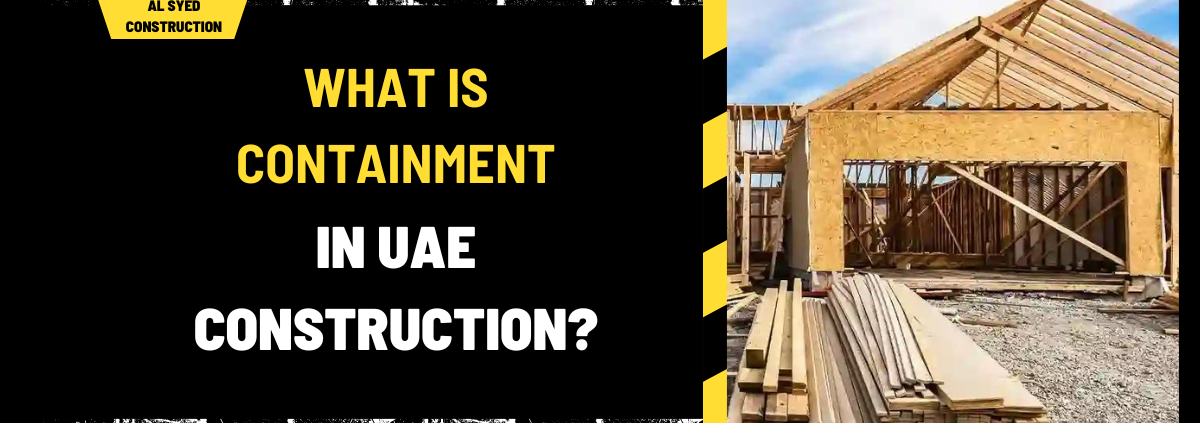What is Containment in UAE Construction? A Comprehensive Guide
In the realm of construction, containment is a critical concept designed to ensure the safety, efficiency, and environmental responsibility of construction projects. This detailed guide explores what containment means in construction, its various types, applications, benefits, and best practices.
Definition and Purpose of Containment in Construction
Containment in construction refers to the strategies and measures used to control and manage the release of contaminants, dust, and hazardous materials during construction activities. The primary purpose of containment is to protect workers, the public, and the environment from potential harm caused by these materials.
Key Objectives of Containment
- Protecting Human Health: Minimizing exposure to harmful substances, such as asbestos or lead, to ensure the safety and health of workers and nearby residents.
- Environmental Protection: Preventing contaminants from escaping into the environment, thus preserving air, soil, and water quality.
- Compliance with Regulations: Meeting legal and regulatory requirements for managing hazardous materials and waste.
Types of Containment Systems
1. Physical Barriers
Physical barriers are essential for isolating construction areas where contaminants or hazardous materials are present. These barriers include:
- Containment Walls: Temporary or permanent walls that enclose areas to prevent the spread of dust and debris.
- Plastic Sheeting: Used to cover surfaces and create barriers that contain contaminants.
- Barriers and Fencing: Safety fences and barriers that restrict access to hazardous areas and protect the public.
2. Enclosed Structures
Enclosed structures provide a controlled environment for handling hazardous materials. Examples include:
- Containment Tents: Portable structures that create a sealed environment for work involving hazardous substances.
- Negative Pressure Enclosures: Specialized rooms or areas where air pressure is controlled to prevent the escape of contaminants.
3. Dust Control Systems
Dust control systems are crucial for managing airborne particles during construction. Common systems include:
- Water Sprays and Misting: Using water to suppress dust and reduce airborne particulates.
- Vacuum Systems: High-efficiency vacuums that capture dust at the source.
- Air Scrubbers: Devices that filter and clean the air to remove dust and contaminants.
4. Waste Management Systems
Effective waste management is integral to containment strategies. This includes:
- Waste Disposal Units: Properly labeled containers for hazardous and non-hazardous waste.
- Recycling Systems: Processes for recycling construction materials and reducing waste.
- Containment Pools: Used for containing and treating liquid waste.
Benefits of Effective Containment
1. Enhanced Safety
Proper containment reduces the risk of exposure to hazardous materials, protecting workers and the public from potential health hazards. It ensures a safer working environment and minimizes the risk of accidents.
2. Regulatory Compliance
Adhering to containment protocols helps construction projects meet local, state, and federal regulations. Compliance with these regulations avoids legal issues and potential fines.
3. Environmental Preservation
Effective containment prevents the release of contaminants into the environment, preserving air, soil, and water quality. This helps mitigate the environmental impact of construction activities.
4. Improved Project Efficiency
By managing contaminants and minimizing disruptions, containment strategies contribute to smoother project execution. Reduced cleanup efforts and fewer regulatory issues enhance overall project efficiency.
Best Practices for Implementing Containment
1. Planning and Assessment
Before initiating construction, conduct a thorough assessment to identify potential contaminants and determine appropriate containment measures. Develop a detailed containment plan outlining strategies and responsibilities.
2. Training and Awareness
Ensure that all personnel are trained in containment procedures and aware of the associated risks. Regular training and updates help maintain a high level of safety and compliance.
3. Regular Inspections
Conduct regular inspections of containment systems to ensure their effectiveness. Check for any breaches or failures and address them promptly to maintain a secure environment.
4. Maintenance and Upgrades
Regularly maintain and upgrade containment equipment and systems to ensure optimal performance. Replace or repair any damaged components to prevent potential issues.
5. Documentation and Reporting
Maintain comprehensive documentation of containment procedures, inspections, and incidents. Accurate records are essential for regulatory compliance and for tracking the effectiveness of containment measures.
Case Studies in Containment
1. Asbestos Abatement Projects
In projects involving asbestos, containment systems are crucial to prevent the release of asbestos fibers into the air. Enclosed work areas and negative pressure systems are often used to manage and contain asbestos safely.
2. Lead Paint Removal
Lead paint removal requires strict containment measures to avoid lead contamination. Use of physical barriers, specialized containment tents, and dust control systems ensures that lead dust does not spread to other areas.
3. Hazardous Waste Management
Projects that involve hazardous waste, such as chemical spills or contaminated soil, use containment pools and waste disposal units to manage and contain waste. Proper procedures for handling and disposal are critical for environmental protection.
Conclusion
Containment in construction is a fundamental practice that ensures safety, regulatory compliance, and environmental protection. By implementing effective containment systems and best practices, construction projects can mitigate risks, manage contaminants, and achieve successful outcomes. Whether through physical barriers, enclosed structures, or advanced dust control systems, proper containment is essential for maintaining a safe and efficient construction process.




